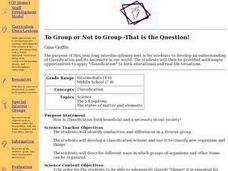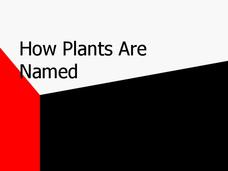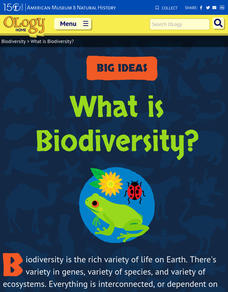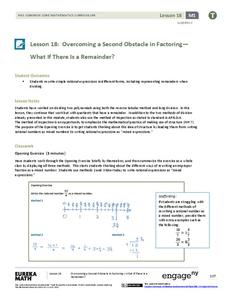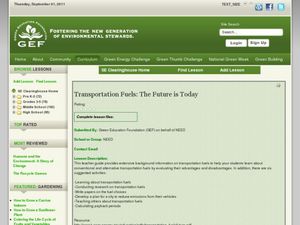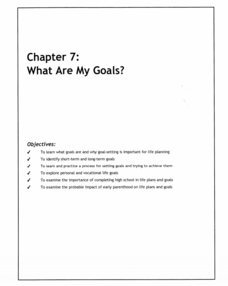Curated OER
Goldie Girl and There, Their, and They're: Homophones and Homographs
Instruct your class on homonyms and homophones. Learners take a pre-test and examine a list of homophones. They also play online word games to practice spelling and usage and write a fairy tale in which they use at least 10 homophones....
Illustrative Mathematics
How Much is a Penny Worth?
Are pennies really worth one cent? Here, learners use rates to calculate the price per pound of copper that would result in pennies that are exactly one cent's worth of copper. Might work best as a group or whole-class activity since the...
Curated OER
Where's the Beef - Beef Facts or Hype, Is it Bad for You?
Analyze a Happy Meal™ for nutrient content and calories. Blend the contents into "McMush" and use Biuret's solution to test for protein content. There are a few problems with the lesson plan: the resource links are no longer...
Curated OER
What is a Noun? & When To Capitalize Nouns
Nouns are the focus of this language arts PowerPoint. Pupils will see that there are five categories of nouns: person, place, thing, idea, quality. The last two are not usually taught, but they are legitimate categories. When to...
Bridge
Mercury - Mercury is Rising
Hold a discussion in your class about the increase in mercury being found in fish that are caught commercially as food for humans. Given a worksheet, learners then calculate how much fish a person can safely eat each month to remain...
Curated OER
A Safe Food Supply? Is Your Food Safe to Eat?
Viewers of this slide show learn that pesticides used on food crops can be harmful, but that there are certain allowable levels that should not be hazardous. They find out the rigorous process of inspection that meat must go through...
Curated OER
To Group of Not to Group - That is the Question!
Upper elementary and middle schoolers use their observation skills to group different kinds of candy by similar characteristics. They debate whether or not we should classify objects. Finally, they learn that biologists have developed a...
Curated OER
Are You Sure You've Got the Right Answer?
Young researchers work through the research cycle. They question, plan, gather, sort, synthesize, and evaluate the materials they collect at the library. There are web supplements for this lesson.
Curated OER
What is Earth Science?
This worksheet tests general knowledge of scientific fields with a focus on those involved in earth science. Learners fill in 9 blanks using the provided word bank of scientific fields. In addition, there are 2 questions specifically...
Curated OER
How Plants Are Named
Here is an interesting set of slides that give some nice examples of the reasoning behind scientific Binomial Nomenclature. Some examples of scientific naming are given along with their common names. There is not much more detail on...
Curated OER
The Phone is for You/Wrong Number
Review basic phone etiquette with your English language learners. There are two example conversations shown. Now, create a few examples of your own!
Curated OER
The Eiffel Tower is the Symbol of Paris
Fashioned in a simple format, the subject of this presentation is the Eiffel Tower in Paris, and could be a model for future projects. Even if your class does not do a unit on famous sites in European cities, this could be used a a way...
Curated OER
Food & Science - How Healthy is Your Diet?
Learners experiment with various foods to determine fat and starch content. They rub jam, peanut butter, bananas, and other foods in a small circle on a piece of paper, and observe the results. If there is a high fat content in the...
Curated OER
Fourth Grade English: Their, They're, and There
While this lesson provides a great idea for an exploration, it is incomplete. Learners are asked to identify the differences between their, they're and there, and discuss homonyms, but there are not activity descriptions. This lesson...
Polar Trec
Is There Salt in a Glacier?
What can conductivity tell us about a glacier? Groups analyze glacial melt to determine salt content through an analysis of the pH and conductivity measurements of two samples. Groups then determine the source of the salts.
EngageNY
Overcoming a Third Obstacle to Factoring— What If There Are No Real Number Solutions?
Time for pupils to use their imagination! Learners examine the relationship between a system with no real solution and its graph. They then verify their discoveries with algebra.
American Museum of Natural History
What is Biodiversity?
Not all dogs are the same just like not all finches are the same. An interactive online lesson helps individuals learn about the causes and limitations to biodiversity. The clickable sections describe the basics of the genetics of...
EngageNY
Overcoming a Second Obstacle in Factoring—What If There Is a Remainder?
Looking for an alternative approach to long division? Show your classes how to use factoring in place of long division. Increase their fluency with factoring at the same time!
Curated OER
Where Is Away?
Students explore garbage. For this landfill lesson, students investigate how much garbage is collected in landfills on average each day. Students discover hazardous materials that are disposed of improperly and the effects of these...
Anti-Defamation League
Is Olympic Coverage Sexist?
Women Olympians have come a long way since 1900 when 22 women competed for the first time. News coverage of the Olympics has also changed dramatically. What has been slow to change, however, is the language used in the coverage of female...
Curated OER
My Antonia: Cubing Strategy
What is love? Why is it important? Explore this concept with an interactive activity that brings together Bloom's taxonomy and Willa Cather's My Antonia. After completing the novel, pupils toss a Bloom's cube and then answer the...
American Museum of Natural History
What is Marine Biology?
A marine environment covers the majority of the earth but is arguably the least understood. Teach young scientists about the characteristics of oceans and ocean species using an interactive online lesson. The in-person or remote learning...
Curated OER
Transportation Fuels: The Future is Today
Assign each group of 3-4 upper elementary engineers to a different type of transportation fuel. A background information page is provided to get them started with researching their assigned fuel. Each group then produces an exhibit...
Advocates for Youth
What Are My Goals?
Empower the teenagers in your class with the knowledge that their future is theirs to control! A set of nine lessons on setting academic, financial, and life goals encourage class members to think about where they'd like to be in ten...






